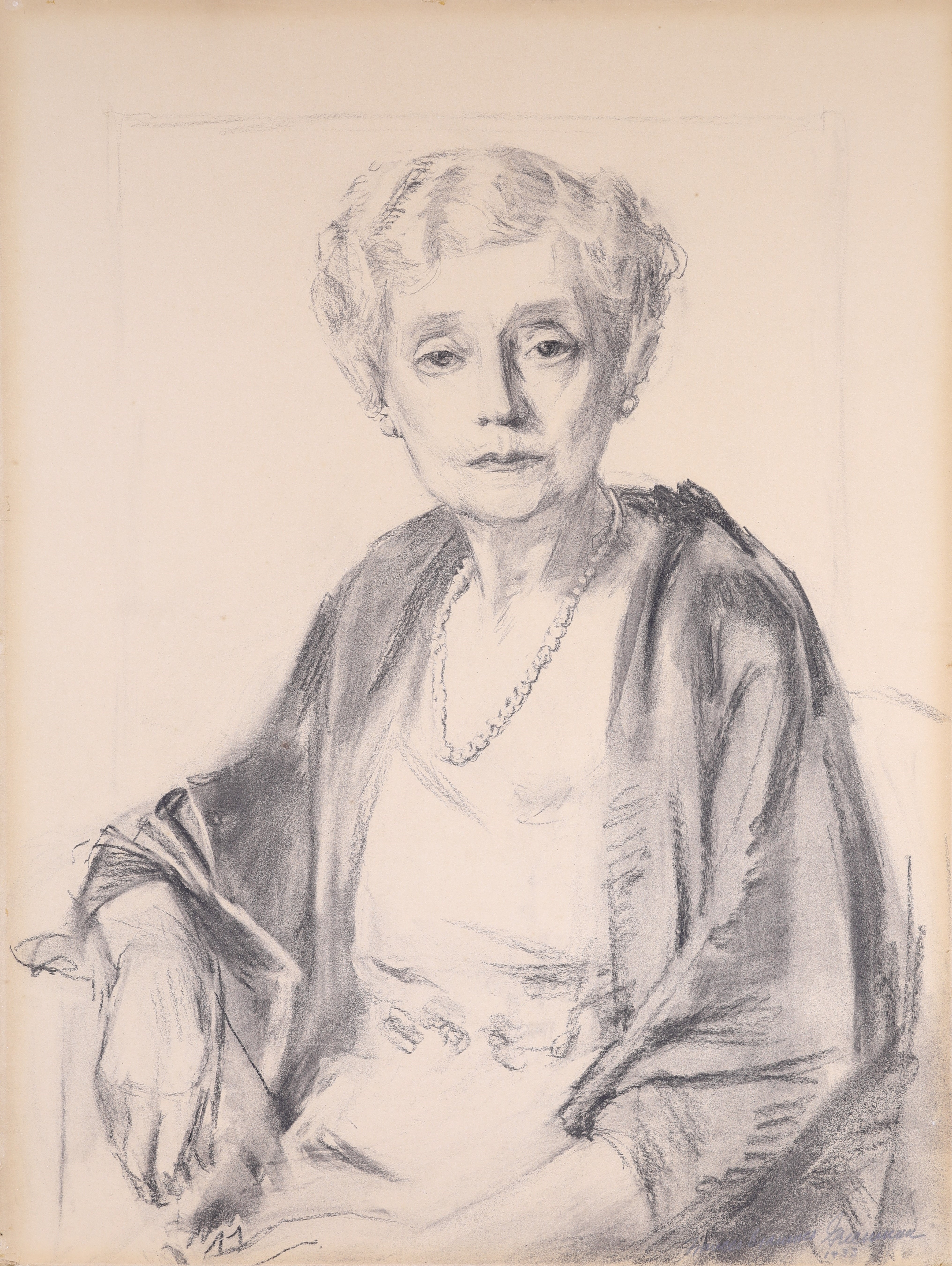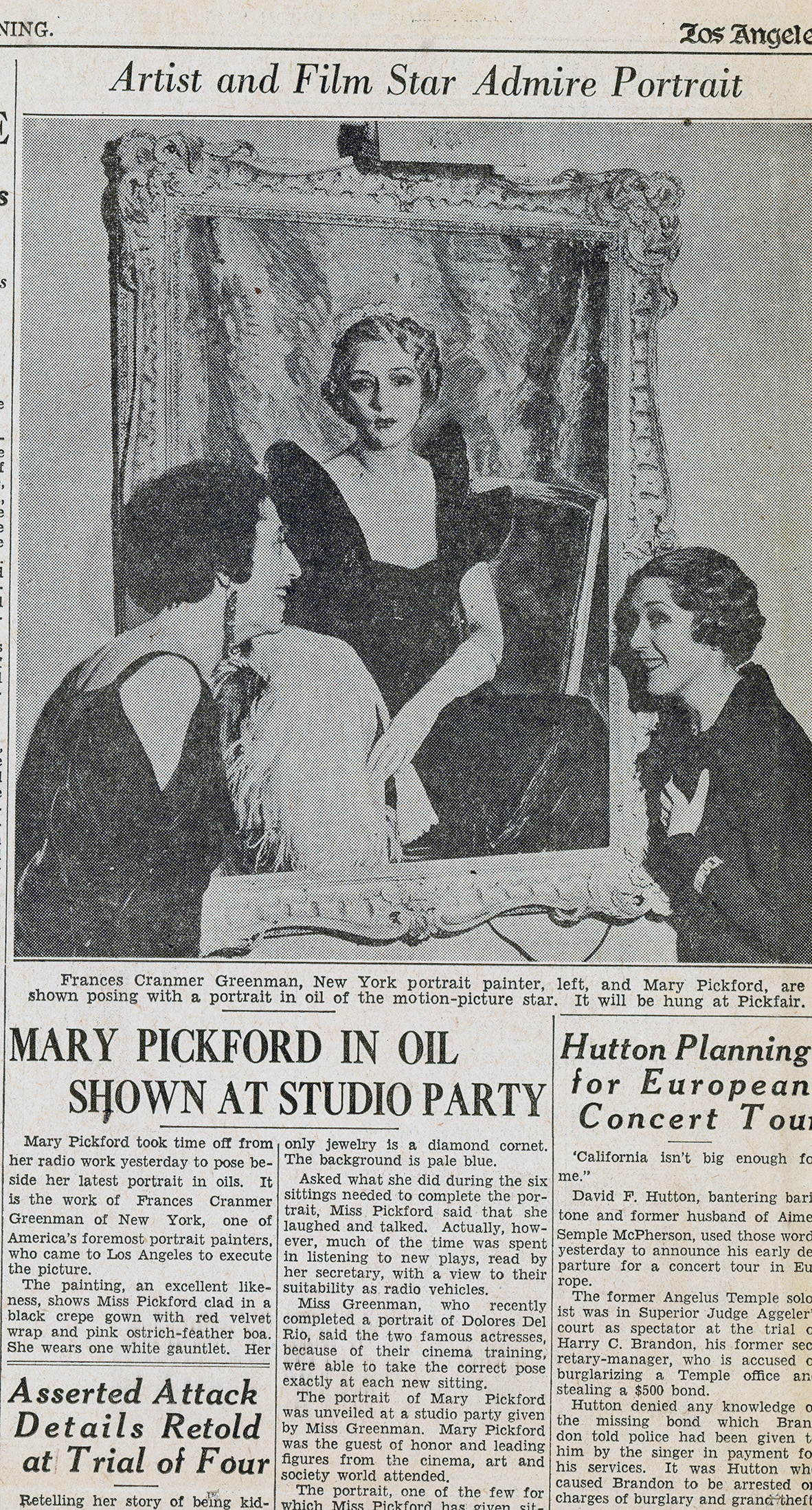April 19, 2019

Portrait of Emma Cranmer by her daughter, Frances Cranmer Greenman. Image from HHM Collections.
On June 28th, 1890 Emma Powers Cranmer had her first and only child named Frances Willard Cranmer in Aberdeen, South Dakota. Emma was an active women’s suffragist that traveled around the United States attending marches and giving speeches. It’s no surprise she named her child after prominent suffragist, Frances Willard. Emma’s daughter Frances would go on to achieve renown and become an important figure in a new a wave of female artists during the 20th century.
In 1906, Frances Cranmer was a young teenager living in Minneapolis, Minnesota. At the age of 16 years old, she decided to become a portrait painter, so she left home to attend school on the east coast. Frances arrived at the Corcoran School of Art in Washington D.C. with her portfolio in hand, but had a tough time getting accepted into school. The director didn’t feel she had the skills to study there and initially denied her acceptance. After noticing how strongly Frances wanted to be admitted into the school, the director put Frances on a probationary period which culminated in Frances receiving a permanent seat in the class. In 1908, at the end of her second year in DC, she was the recipient of the prestigious gold medal awarded annually to one art student at the Corcoran School of Art. She went on to study at the Boston Museum School of Fine Arts, the Art Students League in New York under William Merritt Chase and Robert Henri, and la Grande Chaumière in Paris. During her time in Paris, she visited the famous Louvre Museum to paint an object for one of her assignments. The day she decided to visit the museum she was unable to enter because it was the same day Leonardo da Vinci’s “Mona Lisa” was stolen in 1911. Denied entrance and unable to complete her assignment, she decided to join a school trip to paint landscapes in Switzerland. When crossing the border, the art students’ bags were ransacked as they were considered suspects in the theft of the Mona Lisa.

Portrait of Frances Cranmer Greenman. Image from HHM Archives.
Throughout Frances’s education, she developed exceptional skills needed to pursue a career as an artist. Shortly after returning from abroad, Frances met John Greenman and they wed in 1915. John was supportive of Frances’ career and saw her work as equally important as his. Throughout her career, Frances was recognized as being one of the best American painters of children’s portraits. She loved to paint children especially her own, Coventry and Patty. Child portraiture is difficult for artists because it’s hard to get children to sit still. Frances’s trick was to entertain them through objects. First, Frances would give the child a hammer, a nail, and a potato. The child would observe the objects and learn each’s purpose by using the hammer to pound the nail into the potato. Once the child was tired of these objects, she would sing and tell them stories.
Frances gained valuable skills throughout her collegiate career but didn’t acquire expertise until she started receiving private commissions for portrait artworks. Along with painting children, Frances was known for painting portraits of the Minneapolis elite including Emil Oberhoffer, founder of the Minneapolis Symphony Orchestra, Idabelle Smith Firestone, wife to the founder of Firestone tires, Alfred G. Pillsbury, co-founder of Pillsbury corporations, William Hamm Jr., executive and grandson of the founder of Hamm’s Brewery, Karl Rolvaag, thirty-first governor of Minnesota, which still hangs today in the St. Paul Capitol. In addition, Frances painted portraits of famous Hollywood figures including Olga Petrova, an actress, Lynn Fontaine, an actress, Howard Greer, a costume and fashion designer, Donald Ogden Steward, an author and screenwriter, Ella Wheeler Wilcox, an author and poet, Dolores del Rio, an actress, Jesse Lasky, a motion picture producer, and Ernest Pascal, a screenwriter and playwright. Throughout her life, Frances was captivated by the sophistication of elites and socialites. She enjoyed the glamorous “Hollywood” life she gained through painting portraits of famous celebrities. A high-profile portrait that was widely acclaimed as an indication of her success was of Mary Pickford, a Hollywood motion picture actress, writer, director, and producer known as “America’s Sweetheart”. Frances obtained much praise for her portrait of Pickford and became known as one of the country’s foremost portrait oil painters. The portrait was completed in 1935 and was unveiled at a studio party thrown by Frances with Mary as the guest of honor and in attendance were high profile elites from the art and cinematic world. The portrait of Mary Pickford was a turning point in Frances’s career that highlighted her success as an artist.

Clipping from The Los Angeles Times, February 16, 1935. Image from HHM Archives.
In the 1940’s, Frances was offered a position to teach at the Minneapolis School of Art in the Fine Arts department, now known as the Minneapolis College of Art and Design. One of her most famous students was Minnesota native George Morrison whom she helped secure scholarships funds for as she saw potential in his abilities and creativity to become an outstanding artist. Frances also guest lectured at the renowned Art Institute of Chicago educating art students about portraiture painting and her experience as an artist. Throughout Frances’s life, her paintings gained notable distinction nationally and internationally. Her exhibitions were displayed at the Minnesota State Arts Commission in St. Paul, the Exhibition of American Art in Paris, the New Gallery in New York, the Art Institute of Chicago, the Minneapolis Institute of Arts, the Smithsonian American Art Museum in Washington DC, the Minnesota Museum of American Art, the Sterner Gallery in New York, the Stendhal Galleries in Los Angeles, the Minnesota Historical Society in St. Paul, and at an international exhibit at Carnegie Institute of Pittsburgh. By 1961, Frances was thought to have painted between eight hundred and one thousand portraits.
When Frances was thirty years old in 1920, Congress ratified the nineteenth amendment giving women the right to vote. Being one of a few women in a field dominated by men, Frances helped change the outlook on female artists. Frances career had an impact on the American modernist movement as well as the women’s movement. In 1981, Sun Newspapers wrote of Frances expressing, “She painted the soul, the vibrance of each personality in a manner that truly lives.” Frances ability to capture the essence of an individual in a portrait showed the brilliance of her work and distinction as an artist. Through determination and her talent as an artist, she became a leader of an underrepresented group that provided strength to the first wave of Feminism.
Author: Amber Januszewski is a Collections Intern at Hennepin History Museum. She is pursuing a bachelor’s degree in History from the University of Minnesota with minors in Art History and Medieval Studies.
Sources
Burke, Evelyn. “Frances Greenman stroked her way quickly to fame.” Sun Newspapers, June 10, 1961.
Flanagan, Barbara. “Portrait of a Portrait Painter–Mrs. Greenman.” Minneapolis Sunday Tribune, January 29, 1961.
Henri, Robert, Sarah Burns, Erika Doss, Betsy Fahlman, Helen Langa, Gwendolyn Owens, Lois Palken Rudnick, Marian Wardle. American Women Modernists: The Legacy of Robert Henri, 1910-1945, (New Brunswick, New Jersey, and London; Brigham Young University Museum of Art in association with Rutgers University Press, 2005).
Joint Resolution of Congress proposing a constitutional amendment extending the right of suffrage to women, approved June 4, 1919.; Ratified Amendments, 1795-1992; General Records of the United States Government; Record Group 11; National Archives.
Lamberton, Gretchen. “The Casual Observer.” Winona Daily News, February 21, 1961.
“Artist and Film Star Admire Portrait: Mary Pickford in Oil Shown at Studio Party.” The Los Angeles Times, February 16, 1935, 12.
Thornley, Stew. Six Feet Under: A Graveyard Guide to Minnesota, (Minneapolis; Minnesota Historical Society Press, 2004), 9-10.
Willard, Frances E., Mary A. Livermore. A Woman of the Century: Fourteen Hundred-seventy Biographical Sketches Accompanied by Portraits of Leading American Women in all Walks of Life, (Buffalo, Chicago, New York; Charles Wells Moulton, 1893), 214-216.
